The Clayton Power LPS2-2000 is an all-in-one lithium power supply that packs a 100Ah LiFePO4 battery, 2000W pure sine wave inverter, DC-DC charger, solar MPPT controller, and intelligent mains charger into a single compact unit weighing just 22.5kg. This integrated approach means you won't need to piece together separate components or work out complicated wiring diagrams. The system delivers both 230V AC and 12V DC power simultaneously, so you're running your kettle while the lights are on and the water pump is working. With 1280Wh total capacity (1020Wh usable at 80Ah), you've got enough power to run a 500W coffee machine for two hours or keep your fridge running all day with juice left over for evening laptop use.
Charging happens three ways without any fuss. The built-in 45A DC-DC charger pulls power from your vehicle's 12V or 24V alternator whilst driving when the ignition signal is detected on C1. The integrated 400W solar MPPT controller accepts 15-50V DC from panels connected to terminal C2, whilst the 550W mains charger tops up when you're on hook-up. These charging methods work independently or in combination, so you're pulling power from multiple sources at once if needed. The front-mounted display shows real-time data on battery state, charge rates, and power consumption, with both simple and advanced view modes available by toggling the up and down navigation buttons.
The system fits motorhomes, campervans, and caravans where space is tight but power demands are high. It sits between the basic setups that struggle with anything beyond lighting and the massive battery banks that cost as much as a used car. You'll run kettles, microwaves, hairdryers, and power tools without the voltage drop that plagues cheaper systems. The 2000W output runs for 10 minutes (1500W continuous at 25°C ambient), with 3000W peak capacity for starting high-draw appliances. One limitation to note is the built-in battery isn't user-replaceable due to the compact sealed design, though you can add external Clayton G4 batteries if you need more capacity. The LPS2-2000 comes with Neutrik locking connectors for 230V connections (preventing accidental disconnection), M8 terminals for DC, and includes safety features like 30mA/13A RCBO protection, overcharge prevention, and thermal management through forced air cooling.
The powerful and compact LPS provides power to your 230 VAC and 12 VDC appliances without the complexities of additional equipment.
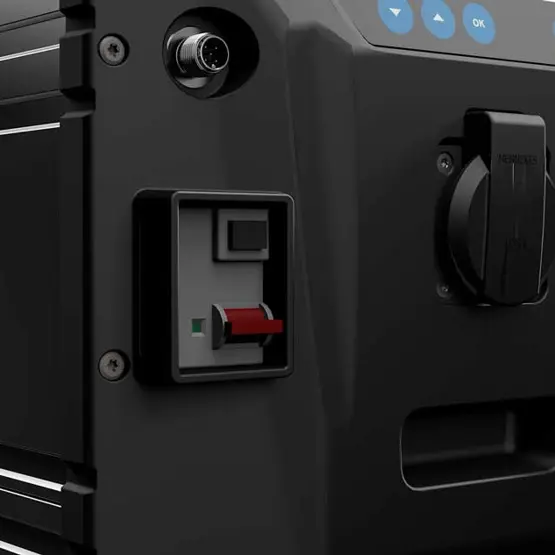 RCBO relay
RCBO relayThe RCBO relay is included in the LPS. In case of overload, it will shut down for the 230V AC output. The RCBO relay is also a fault current circuit breaker.
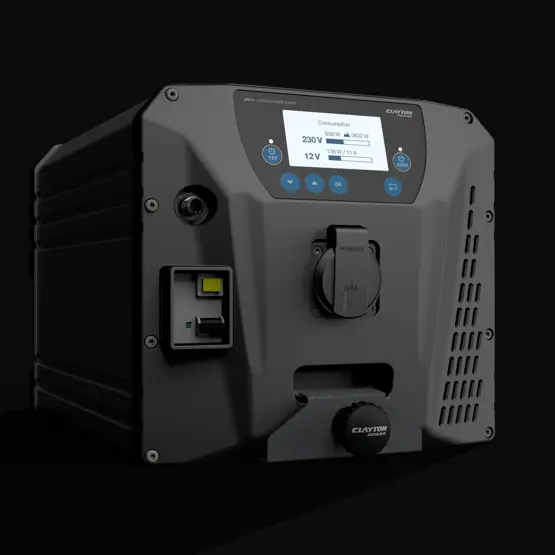 Switch for 12V DC Output
Switch for 12V DC Output12V DC can be turned ON/OFF from the front of the LPS. If pressing OK the LPS will enter the main menu. From the main menu it is possible to find data for DC charging and 12V DC output.
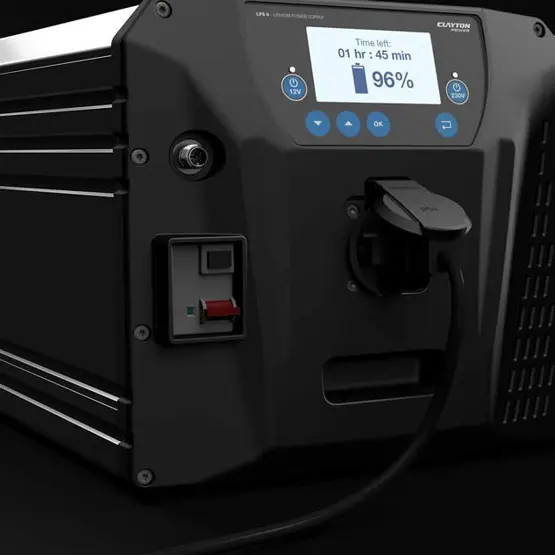 230V output Schuko plug
230V output Schuko plugIn front of the LPS it is possible to e.g., connect 230V equipment or an extension cord.
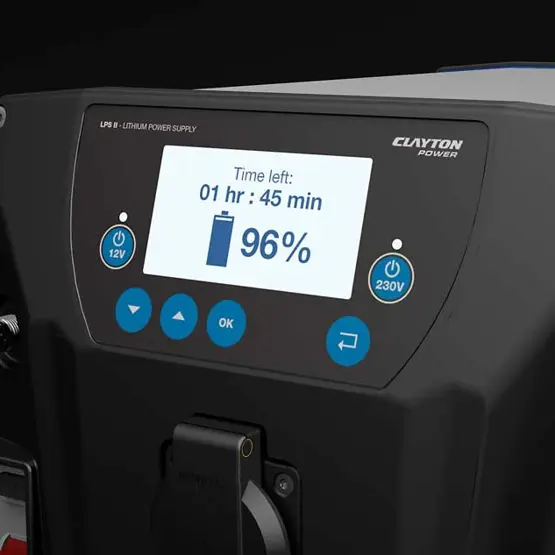 Switch for 230 VAC output
Switch for 230 VAC output230 VAC can be turned ON/OFF from the front of the LPS. If pressing OK the LPS will enter the main menu. From the main menu it is possible to find data for AC charging and 230 VAC output.
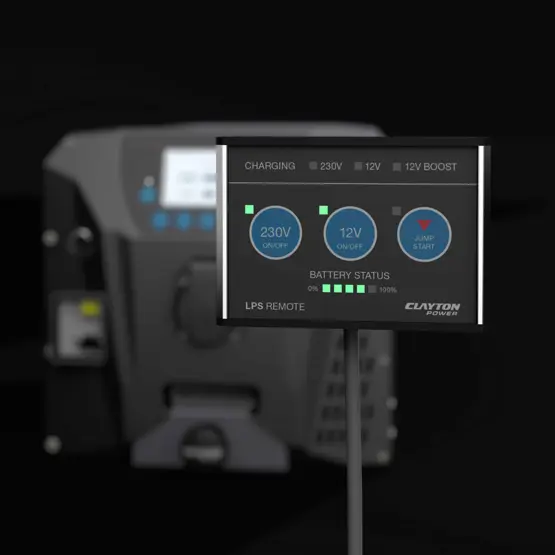 Remote and data
Remote and dataThere is an M12 connection for the remote control. The remote control can be used for turning on/off the LPS.
The M12 data connection is for upload of software updates, change of parameters or withdrawal of data from the LPS via a can modem.
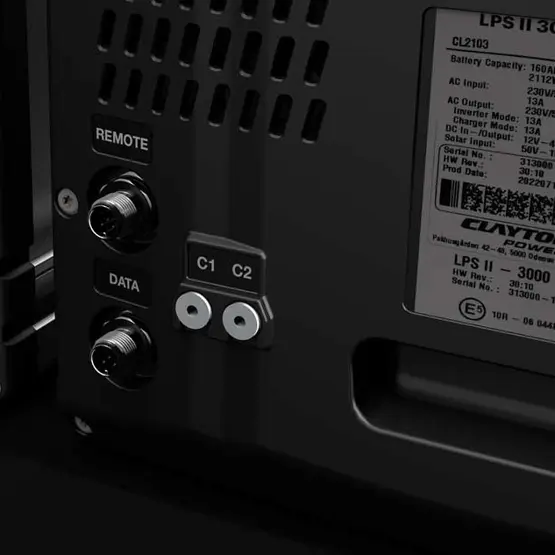 C1 and C2 connection
C1 and C2 connectionC1: For charging from the vehicle, it is required to connect C1 to D+ or the ignition key.
C2: For charging from solar panels, it is required to connect to C2. Solar panels shall also be connected to DC -IN or for DC OUT.
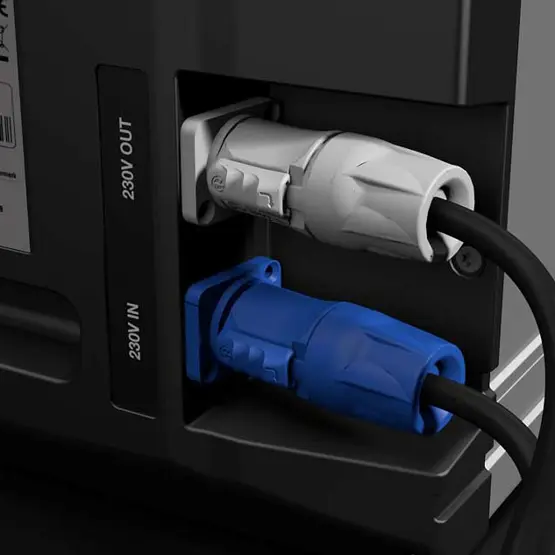 230V IN and OUT
230V IN and OUTThe grey Neutrik connector is included for 230V AC output.
The blue Neutrik connector is for 230V AC input. The charging cable with the blue Neutrik is shipped together with LPS II.
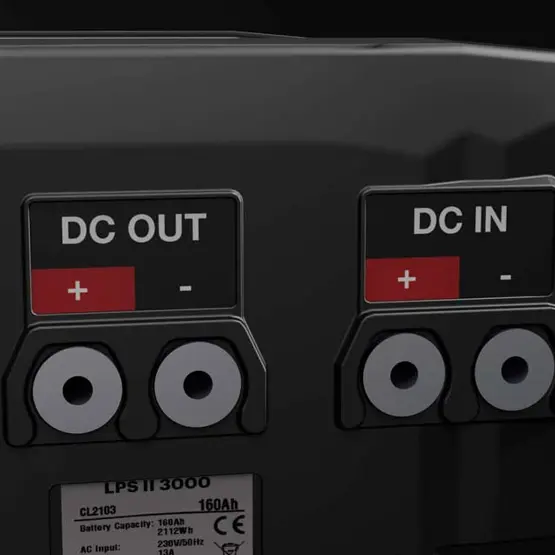 12V DC output
12V DC output12V DC appliances can be connected to the output terminals.
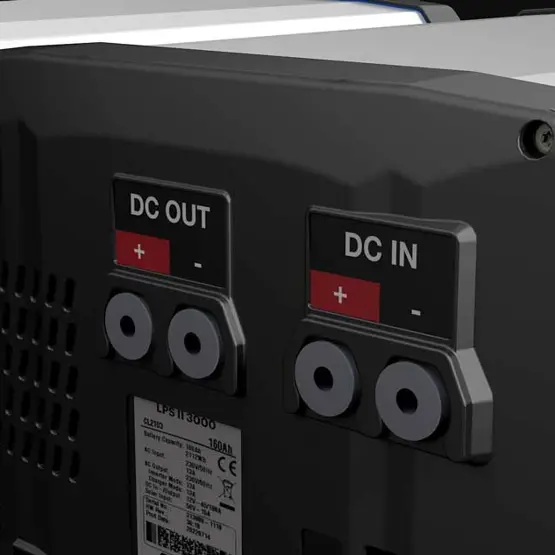 12V or 24V DC input
12V or 24V DC inputThe LPS is charged from any alternator via the 12 or 24V DC input. The DC IN shall be connected to the starter battery. The built-in booster will raise the voltage and at the same time also protect the starter battery.
For charging from solar panels, they shall also be connected to DC -IN or for DC OUT (and C2).
-53300.webp) High energy density Li-Ion Battery Cells
High energy density Li-Ion Battery CellsHigh-end and compact LiFePO4 battery cells with high energy density and long lifetime.
 Efficient high-voltage AC unit
Efficient high-voltage AC unitRedesign of all functionalities for making the LPS unit as ultra compact as possible. The high-voltage AC inverter has an impressive 94% efficiency at 1000 W and high peak performance for start-up of heavy-duty loads.
-19705.webp) Redesigned boards and made for harsh environments
Redesigned boards and made for harsh environmentsAll boards within Clayton Power's LPS are coated to ensure maximum functionality even in challenging environments. The inverter, charger, solar regulator, and DC booster have been redesigned to make the product as compact and efficient as possible.
Clayton Power LPS II 2000 Features
- Charging from alternator : The built-in booster allows regeneration with 500 W from any alternator. 500 W (45 A) standard. 1000 W (90 A) Super Charger (not included).
- Charging from solar panels : Connect solar panels directly. The built-in solar charge controller also allows regeneration from the sun with 400 W.
- Charging from mains : Connect to mains, the built-in intelligent charger regenerates with 750 W.
- 230 V/50 Hz output : Peak: 3000 W | Power: 2000 W
- 12 V output : 60 Seconds: 270 A | Continously: 180 A
- Built-in Li-Ion Battery : Capacity: 1320 Wh (100 A) | Efficient energy: 1000 Wh
- Charging : Alternator: 500 W / SC: 1000 W | Solar panels: 400 W | Mains: 750 W
- Jumpstart
- Status overview
- Charging summary
- Additional battery option
- Clayton Power GO App
Specifications
- SKU No.: CL2205
- Battery type: Li-Ion 12V – 100Ah
- Battery chemistry: LiFePO4
- Battery capacity: 100Ah (1320Wh)
- Battery available capacity: 80Ah (1050Wh)
- AC Input voltage: 207 VAC – 253 VAC
- AC input frequency: 45 Hz – 65 Hz
- AC Input power (Charge power): 720 W
- AC Output voltage: 230 VAC ±10% pure sine wave
- AC Output frequency: 50 Hz
- AC output power – Continuously (ambient temp): 1500 W
- AC output power - 10 min.: 2000 W
- AC output power - Peak: 3000 W
- AC output power - AC In connected: 2300 W
- AC output efficiency (1000W): 94%
- DC Input voltage: 11.5 - 32 VDC
- DC input current: 45 A
- DC input current with 1 external converter (efficiency): 90 A
- DC output voltage: 10-14.4 VDC
- DC output charge current – Continuously: 90 A
- DC output discharge current – Continuously: 180 A
- DC output discharge current – 1 min.: 270 A
- Solar input charging power (max.): 400 W
- Solar input voltage: 15 – 50 VDC
- Solar input charging current (max.): 15 A
- Input signals: (5) C1, C2, M12 x 3
- Output signals: (4) C2 & M12 x 3
- Self-discharge rate per month: < 5%
- Self consumption - Operating mode, Only DC Output active: < 1 W
- Self consumption - Operating mode, inverter and DC Output in with > 50 W: 20 W
- Connection 230 VAC: Neutrik and Schuko
- Connection C1 / C2: M4
- Connection DC input: M8
- Connection DC output: M8
- Cooling: Forced air (fan)
- Operating temperature: -20°C~50°C (output will be limited below 0°C and above 50°C)
- IP rating: IP21
- Product weight: 22.5 kg
- Product dimensions (HxWxL): 256x277x409 mm
- Jumpstart: 40 A / 5 min
-96112.webp)
Frequently Asked Questions
The LPS2-2000 has 1280Wh total capacity with 1020Wh usable (80Ah at 12V), meaning you can run a 1000W appliance for approximately one hour, a 500W device for two hours, or a 250W load for four hours from the usable capacity. In real-world terms, this powers a coffee machine for an hour plus LED lighting for five hours, or keeps a 40W compressor fridge running for 24 hours with power left over for phone charging and laptop use. The LiFePO4 battery maintains stable voltage output throughout discharge, unlike lead-acid batteries that drop voltage as they deplete.
No additional equipment is required for basic installation. The LPS2-2000 has an integrated 45A DC-DC charger that safely charges from any 12V or 24V vehicle alternator, protecting your starter battery whilst pulling charging power. You connect directly to your starter battery terminals with minimum 16mm² cable (60A slow blow fuse required) and link the D+ ignition signal wire to terminal C1 using minimum 1.5mm² cable through a 5A car fuse. The unit only charges when it detects the ignition signal, preventing starter battery drain. The charging current is adjustable through the display menu if your alternator has limited output capacity.
Yes, the LPS2-2000 replaces separate leisure batteries, inverters, battery chargers, solar controllers, and DC-DC chargers with one integrated unit. This eliminates complex wiring between multiple components and saves considerable space. The unit delivers 2000W for 10 minutes (1500W continuous at 25°C) with 3000W peak at 230V AC plus 180A continuous (270A for 1 minute) at 12V DC, handling most motorhome and campervan applications. You mount it securely using the optional mounting bracket (must be upright, never on side or upside down), connect to your starter battery, add the ignition signal wire, and optionally connect solar panels and mains input. The system automatically manages all charging sources and outputs.
The pure sine wave inverter handles 2000W for 10 minutes (1500W continuous at 25°C ambient temperature), with 3000W peak capacity for 10 seconds to handle startup surge from appliances. This runs kettles up to 1500W, 800W microwaves, induction hobs, coffee machines, hairdryers up to 1500W, power tools, laptops, phone chargers, and most domestic appliances simultaneously up to the power limit. The 94% efficiency at 1000W means less battery drain compared to cheaper inverters. The 13000W supported peak inrush power handles the startup surge from compressor fridges, power tools, and pumps that draw several times their running wattage for brief moments. When connected to mains input, the unit can output 2300W to AC appliances.
The integrated 400W MPPT solar controller accepts 15-50V DC input with maximum 15A charging current and 30A short circuit current rating. Connect the solar panel negative to the DC IN negative terminal, then connect the solar positive to terminal C2 on the LPS2-2000. The positive C2 connection enables the solar charging function. The system automatically charges when panels generate more than 5W of power. An optional DC isolation switch between the panels and LPS2-2000 is recommended for safety when servicing. The MPPT will be permanently damaged if input voltage exceeds 50V, so verify your panel open circuit voltage stays below this limit. The display menu shows solar input voltage, current, and power in real-time.
The LiFePO4 battery is rated for 2000 complete charge cycles before capacity degradation becomes significant. This typically equals 10 years of regular use in motorhome and campervan applications, assuming charging and discharging the battery most days throughout a typical camping season. LiFePO4 chemistry provides stable performance with minimal capacity degradation over time compared to other lithium chemistries. The battery operates from minus 20°C to plus 50°C for discharge, though charging only occurs between 0°C and 50°C. The battery cannot be user-replaced due to the compact sealed design, but you can expand total capacity by connecting external Clayton G4 batteries to the system. The unit requires a full recharge every month for optimal performance.
Yes, the LPS2-2000 integrates with standard motorhome electrical systems. The 12V DC output connects to your existing 12V distribution panel or fuse box using minimum 16mm² cable with appropriate fusing, powering all your 12V appliances including lights, water pump, heating controls, and USB sockets. The 180A continuous output (270A for 1 minute) handles high-draw 12V loads. The 230V AC output provides power through either the front-mounted Schuko socket or rear Neutrik connector, which you wire to your 230V distribution system. Both outputs are independently switched on the front panel. When connected to mains hook-up via the blue Neutrik connector, the system charges the battery at 550W whilst simultaneously powering your 230V appliances at up to 2300W, automatically managing the power distribution.
Multiple protection systems are integrated throughout the unit. The 230V AC input has a non-replaceable 16A fuse, whilst the AC output includes a Residual Current Circuit Breaker with Overload protection rated at 30mA and 13A that automatically disconnects on overload or fault current. The DC input is protected by a 50A fuse, and solar input by a 20A fuse. The battery management system prevents overcharging, over-discharging, short circuits, and thermal issues. Forced air cooling maintains safe operating temperatures, with the fan activating automatically when needed. The unit must be mounted upright with adequate airflow around all sides (IP20 rating). All boards are conformal coated for protection against moisture and vibration. L/N and PE/N relay hardware provides additional hazard protection. Regular RCBO testing is recommended by pressing the T button whilst 230V is present.
Yes, you can connect Clayton Power G4 lithium-ion batteries as additional storage to increase total capacity beyond the internal 100Ah (1280Wh). These external batteries link to the LPS2-2000 system, with the unit managing charging and discharging across all connected batteries. This approach suits installations where the internal capacity is not sufficient for your daily power consumption, particularly if you are running high-draw appliances for extended periods or spending multiple days without driving or shore power. The front display and Clayton Power GO app show combined state of charge for the complete battery bank. The internal battery itself cannot be removed or replaced by users due to the sealed compact design requiring service by trained personnel.
The LPS2-2000 includes the main unit, one 230V charging cable with blue Neutrik NAC3 FCA connector for mains input (note this cable is not suitable for fixed installation in leisure vehicles), one grey Neutrik NAC3 FCB AC output connector, four M8 bolts and caps for DC connections, two M4 bolts for communication connections, and four rubber feet. Items purchased separately include the mounting bracket (highly recommended for secure upright installation), remote control unit (provides convenient on/off switching and jumpstart activation from a different location with 6 metre cable), alternator connection cables (minimum 16mm² flexible class 5 or 6 cable with appropriate terminals and 60A slow blow fuse), ignition signal wire (minimum 1.5mm² with 5A fuse), and solar panel cables with optional isolation switch. Solar panels are also separate purchases.
The LPS2-2000 has built-in Bluetooth connectivity for monitoring and control via the Clayton Power GO app, available for both Apple and Android devices. You activate Bluetooth in the display menu under Main Menu, General, Bluetooth, Power and set to On. Open the app and scan for devices, then push Connect next to your LPS2-2000. Enter the PIN code displayed on the LPS2-2000 screen when prompted. The app shows real-time system state of charge with estimated time to full or empty, AC mains charging status and power, DC input charging current, solar status, 12V DC output current, and 230V AC output power. You can toggle the 230V and 12V outputs on or off directly from the app. The app provides convenient monitoring without accessing the physical unit, particularly useful when the LPS2-2000 is mounted in a difficult-to-reach location.
The LPS2-2000 requires minimal regular maintenance. Fully recharge the battery to 100% every month for optimal performance. If the battery has not been fully charged for a long period, the maintenance charge process takes up to 3 days. When storing the unit for more than one month, fully charge it first and store at temperatures between 0°C and 35°C. If not being used, the unit must be charged every 6 months to prevent battery degradation. Regular RCBO testing is recommended by pressing the T button when 230V is present to verify the safety circuit breaker functions correctly. A yearly full RCBO test with a suitable test tool is also recommended. Keep ventilation areas clear of dust and obstructions to ensure proper cooling. The unit should never be stored or mounted upside down. Storage outside the recommended temperature range may damage the battery and is not covered by warranty.
Yes, the LPS2-2000 has an integrated jumpstart feature that charges a depleted starter battery. The unit must be connected to the starter battery via the DC IN terminals according to the installation instructions. You activate jumpstart through the display menu under Main Menu, DC Charging, Jumpstart by selecting Active and pressing OK to confirm. Alternatively, use the remote control if fitted to activate the jumpstart function. Once activated, the jumpstart delivers 40A to the starter battery for 5 minutes. The green LED will flash during the jumpstart period. After 5 minutes, the LED stops flashing and the vehicle should start normally. This feature is particularly useful in cold weather or after extended periods without driving when the starter battery has self-discharged.
-17418.webp)
-25500.webp)
-93109.webp)
-11092.webp)
-70208.webp)
-59732.webp)
-54859.webp)
-87668.webp)
-76423.webp)
-31989.webp)
-44972.webp)
-63360.webp)
-81957.webp)
-56365.webp)
-47071.webp)
-72241.webp)
-23784.webp)
-46775.webp)
-36656.webp)
-96112.webp)
-70029.webp)
-15060.webp)